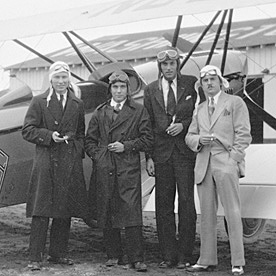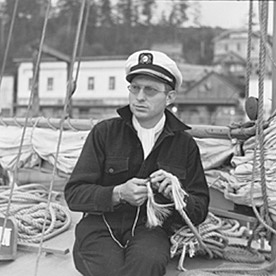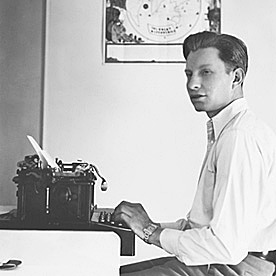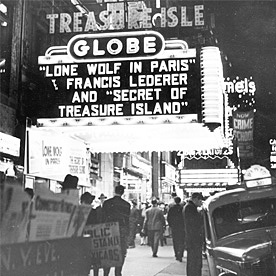Death Waits at Sundown (11 page)
pinwheel:
a movement or trick with a gun; the gun is held in virtual firing
position except that the forefinger is not in the trigger guard. The gun is
flipped into the air so that it revolves and the butt drops naturally into the
palm of the hand.
â to text
plug:
shoot.
â to text
plugged
centavo
:
a worthless coin. A plugged coin was counterfeit or had a plug of
metal removed from the center.
Centavo
is Spanish for a cent or penny.
â to text
plug tobacco:
shredded tobacco leaves pressed into a block.
â to text
polecat:
skunk; a thoroughly contemptible person.
â to text
pulled leather:
grabbed onto the saddle while riding a bucking horse. It shows a
lack of skill or courage, or both. A cowboy hates to have to grab the saddle
horn to stay on, and most will allow themselves to be thrown off before they
will pull leather.
â to text
puncher:
a hired hand who tends cattle and performs other duties on
horseback.
â to text
quirt:
a riding whip with a short handle and a braided leather lash.
â to text
repeater watch:
a pocket watch that chimes every one, twelve or twenty-four hours.
â to text
roostered:
drunk.
â to text
roweled:
having used the small, spiked revolving wheels at the ends of
spurs, rolled across the horse's side.
â to text
rowels:
the small spiked revolving wheels on the ends of spurs, which are
attached to the heels of a rider's boots and used to nudge a horse into going
faster.
â to text
running iron:
a branding iron that is not bent into the shape of the mark, but
rather requires the user to write the desired brand.
â to text
sap:
dumb guy; a fool.
â to text
Scheherazade:
the female narrator of
The Arabian Nights,
who during one
thousand and one adventurous nights saved her life by entertaining her husband,
the king, with stories.
â to text
serape:
a long, brightly colored woolen blanket worn as a cloak by some men
from Mexico, Central America and South America.
â to text
shucks, wasn't
such:
was of little value.
â to text
sombrero:
a Mexican style of hat that was common in the Southwest. It had a
high-curved wide brim, a long, loose chin strap and the crown was dented at the
top. Like cowboy hats generally, it kept off the sun and rain, fended off the
branches and served as a handy bucket or cup.
â to text
sorrel:
a horse with a reddish-brown coat.
â to text
Stetson:
as the most popular broad-brimmed hat in the West, it became the
generic name for
hat.
John B. Stetson was a master hat maker and founder
of the company that has been making Stetsons since 1865. Not only can the
Stetson stand up to a terrific amount of beating, the cowboy's hat has more
different uses than any other garment he wears. It keeps the sun out of the
eyes and off the neck; it serves as an umbrella; it makes a great fan, which
sometimes is needed when building a fire or shunting cattle about; the brim
serves as a cup to water oneself, or as a bucket to water the horse or put out
the fire.
â to text
sunfish:
a way of bucking; the horse throws its middle violently to one
side, then the other, so that it seems its shoulder may touch the ground,
letting the sunlight hit its belly.
â to text
swap ends:
a movement peculiar to a bronc where he quickly reverses his
position, making a complete half-circle in the air.
â to text
thirteenth step:
gallows; traditionally, there are thirteen steps leading up to a
gallows.
â to text
Tipperary:
a town of south-central Ireland, southwest of Dublin. The song
“It's a Long Way to Tipperary” was used as marching music by the British
Expeditionary Force in World War I.
â to text
vigilantes:
citizens banded together in the West as vigilance committees,
without legal sanction and usually in the absence of effective law enforcement,
to take action against men viewed as threats to life and property. The usual
pattern of vigilance committees was to grab their enemies (guilty or not),
stage a sort of trial and hang them. Their other enemies were then likely to
get out of town.
â to text
waddies:
cowboys, especially those who drift from ranch to ranch and help
out in busy times. In the spring and fall when some ranches were short-handed,
they took on anyone who was able to ride a horse and used him for a week or so;
hence the word
waddy
, derived from
waddingâ
anything to fill in.
Some cowmen used the word to mean a cattle rustler; later it was applied to any
cowboy.
â to text
whippersnapper:
an impertinent young person, usually a young man, who lacks proper
respect for the older generation; a youngster with an excess of both ambition
and impertinence.
â to text
Winchester:
an early family of repeating rifles; a single-barreled rifle
containing multiple rounds of ammunition. Manufactured by the Winchester
Repeating Arms Company, it was widely used in the US during the latter half of
the nineteenth century. The 1873 model is often called “the gun that won the
West” for its immense popularity at that time, as well as its use in fictional
Westerns.
â to text
ye:
you.
â to text
L. Ron Hubbard in the
Golden Age of
Pulp Fiction
I
n writing an adventure story
a writer has to know that he is adventuring
for a lot of people who cannot.
The writer has to take them here and there
about the globe and show them
excitement and love and realism.
As long as that writer is living the part of an
adventurer when he is hammering
the keys, he is succeeding with his story.
Adventuring is a state of mind.
If you adventure through life, you have a
good chance to be a success on paper.
Adventure doesn't mean globe-trotting,
exactly, and it doesn't mean great deeds.
Adventuring is like art.
You have to live it to make it real.
â L. Ron Hubbard
L. Ron Hubbard
and American
Pulp Fiction
B
ORN
March 13, 1911, L. Ron Hubbard lived a life at least as expansive as the stories with which he enthralled a hundred million readers through a fifty-year career.
Originally hailing from Tilden, Nebraska, he spent his formative years in a classically rugged Montana, replete with the cowpunchers, lawmen and desperadoes who would later people his Wild West adventures. And lest anyone imagine those adventures were drawn from vicarious experience, he was not only breaking broncs at a tender age, he was also among the few whites ever admitted into Blackfoot society as a bona fide blood brother. While if only to round out an otherwise rough and tumble youth, his mother was that rarity of her timeâa thoroughly educated womanâwho introduced her son to the classics of Occidental literature even before his seventh birthday.
But as any dedicated L. Ron Hubbard reader will attest, his world extended far beyond Montana. In point of fact, and as the son of a United States naval officer, by the age of eighteen he had traveled over a quarter of a million miles. Included therein were three Pacific crossings to a then still mysterious Asia, where he ran with the likes of Her British Majesty's agent-in-place for North China, and the last in the line of Royal Magicians from the court of Kublai Khan. For the record, L.RonHubbard was also among the first Westerners to gain admittance to forbidden Tibetan monasteries below Manchuria, and his photographs of China's Great Wall long graced American geography texts.
Upon his return to the United States and a hasty completion of his interrupted high school education, the young Ron Hubbard entered George Washington University. There, as fans of his aerial adventures may have heard, he earned his wings as a pioneering barnstormer at the dawn of American aviation. He also earned a place in free-flight record books for the longest sustained flight above Chicago. Moreover, as a roving reporter for
Sportsman Pilot
(featuring his first professionally penned articles), he further helped inspire a generation of pilots who would take America to world airpower.

L. Ron Hubbard, left, at Congressional Airport, Washington, DC, 1931, with members of George Washington University flying club.
Immediately beyond his sophomore year, Ron embarked on the first of his famed ethnological expeditions, initially to then untrammeled Caribbean shores (descriptions of which would later fill a whole series of West Indies mystery-thrillers). That the Puerto Rican interior would also figure into the future of Ron Hubbard stories was likewise no accident. For in addition to cultural studies of the island, a 1932â33 LRH expedition is rightly remembered as conducting the first complete mineralogical survey of a Puerto Rico under United States jurisdiction.
There was many another adventure along this vein: As a lifetime member of the famed Explorers Club, L.RonHubbard charted North Pacific waters with the first shipboard radio direction finder, and so pioneered a long-range navigation system universally employed until the late twentieth century. While not to put too fine an edge on it, he also held a rare Master Mariner's license to pilot any vessel, of any tonnage in any ocean.

Capt. L. Ron Hubbard in Ketchikan, Alaska, 1940, on his Alaskan Radio Experimental Expedition, the first of three voyages conducted under the Explorers Club Flag.
Yet lest we stray too far afield, there is an LRH note at this juncture in his saga, and it reads in part:
“I started out writing for the pulps, writing the best I knew, writing for every mag on the stands, slanting as well as I could.”
To which one might add: His earliest submissions date from the summer of 1934, and included tales drawn from true-to-life Asian adventures, with characters roughly modeled on British/American intelligence operatives he had known in Shanghai. His early Westerns were similarly peppered with details drawn from personal experience. Although therein lay a first hard lesson from the often cruel world of the pulps. His first Westerns were soundly rejected as lacking the authenticity of a Max Brand yarn (aparticularly frustrating comment given L.RonHubbard's Westerns came straight from his Montana homeland, while Max Brand was a mediocre New York poet named Frederick Schiller Faust, who turned out implausible six-shooter tales from the terrace of an Italian villa).
Nevertheless, and needless to say, L.RonHubbard persevered and soon earned a reputation as among the most publishable names in pulp fiction, with a ninety percent placement rate of first-draft manuscripts. He was also among the most prolific, averaging between seventy and a hundred thousand words a month. Hence the rumors that L.RonHubbard had redesigned a typewriter for faster keyboard action and pounded out manuscripts on a continuous roll of butcher paper to save the precious seconds it took to insert a single sheet of paper into manual typewriters of the day.

L. Ron Hubbard, circa 1930, at the outset of a literary career that would span half a century.
That all L. Ron Hubbard stories did not run beneath said byline is yet another aspect of pulp fiction lore. That is, as publishers periodically rejected manuscripts from top-drawer authors if only to avoid paying top dollar, L. Ron Hubbard and company just as frequently replied with submissions under various pseudonyms. In Ron's case, the list included: Rene Lafayette, Captain Charles Gordon, Lt. Scott Morgan and the notorious Kurt von Rachenâsupposedly on the lam for a murder rap, while hammering out two-fisted prose in Argentina. The point: While L.Ron Hubbard as Ken Martin spun stories of Southeast Asian intrigue, LRH as Barry Randolph authored tales of romance on the Western rangeâwhich, stretching between a dozen genres is how he came to stand among the two hundred elite authors providing close to a million tales through the glory days of American Pulp Fiction.

A Man of Many Names
Between 1934 and 1950, L. Ron Hubbard authored more than fifteen million words of fiction in more than two hundred classic publications.
To supply his fans and editors with stories across an array of genres and pulp titles, he adopted fifteen pseudonyms in addition to his already renowned L. Ron Hubbard byline.
______
Winchester Remington Colt
Lt. Jonathan Daly
Capt. Charles Gordon
Capt. L. Ron Hubbard
Bernard Hubbel
Michael Keith
Rene Lafayette
Legionnaire 148
Legionnaire 14830
Ken Martin
Scott Morgan
Lt. Scott Morgan
Kurt von Rachen
Barry Randolph
Capt. Humbert Reynolds

In evidence of exactly that, by 1936 L. Ron Hubbard was literally leading pulp fiction's elite as president of New York's American Fiction Guild. Members included a veritable pulp hall of fame: Lester “Doc Savage” Dent, Walter “The Shadow” Gibson, and the legendary Dashiell Hammettâto cite but a few.
Also in evidence of just where L.Ron Hubbard stood within his first two years on the American pulp circuit: By the spring of 1937, he was ensconced in Hollywood, adopting a Caribbean thriller for Columbia Pictures, remembered today as
The Secret of Treasure Island.
Comprising fifteen thirty-minute episodes, the L. Ron Hubbard screenplay led to the most profitable matinée serial in Hollywood history. In accord with Hollywood culture, he was thereafter continually called upon to rewrite/doctor scriptsâmost famously for long-time friend and fellow adventurer Clark Gable.

The 1937
Secret of Treasure Island,
a fifteen-episode serial adapted for the screen by L. Ron Hubbard from his novel,
Murder at Pirate Castle
.
In the interimâand herein lies another distinctive chapter of the L.Ron Hubbard storyâhe continually worked to open Pulp Kingdom gates to up-and-coming authors. Or, for that matter, anyone who wished to write. It was a fairly unconventional stance, as markets were already thin and competition razor sharp. But the fact remains, it was an L.RonHubbard hallmark that he vehemently lobbied on behalf of young authorsâregularly supplying instructional articles to trade journals, guest-lecturing to short story classes at George Washington University and Harvard, and even founding his own creative writing competition. It was established in 1940, dubbed the Golden Pen, and guaranteed winners both New York representation and publication in
Argosy.